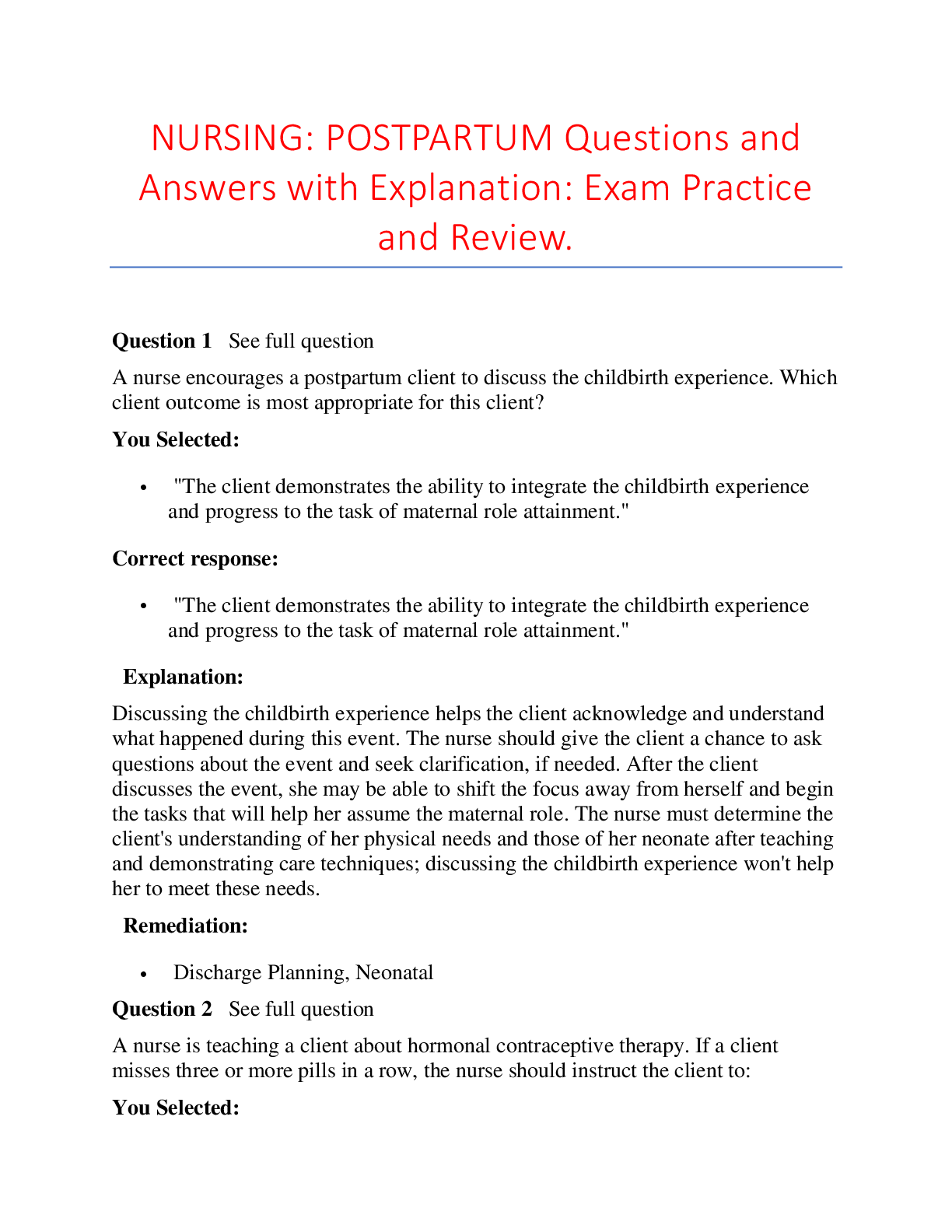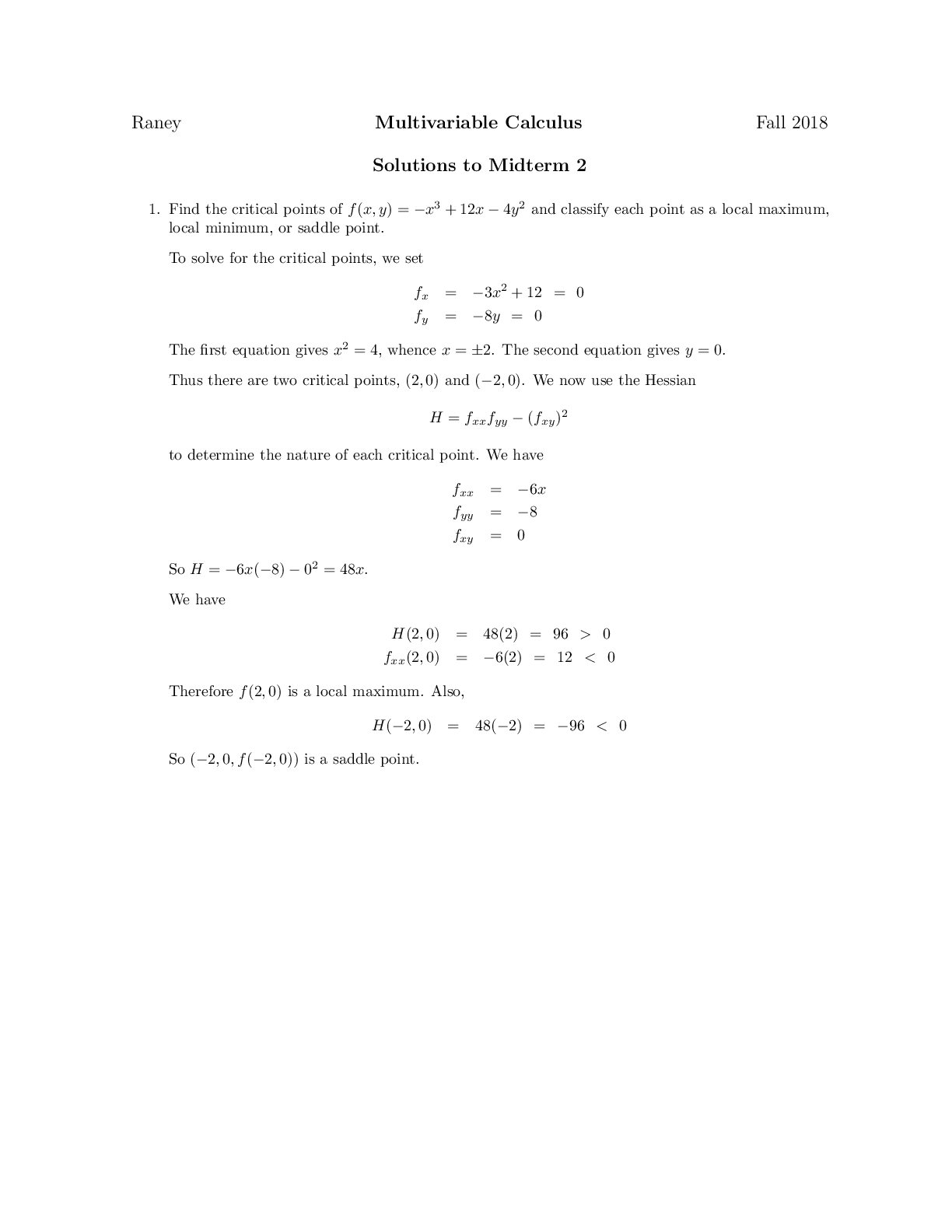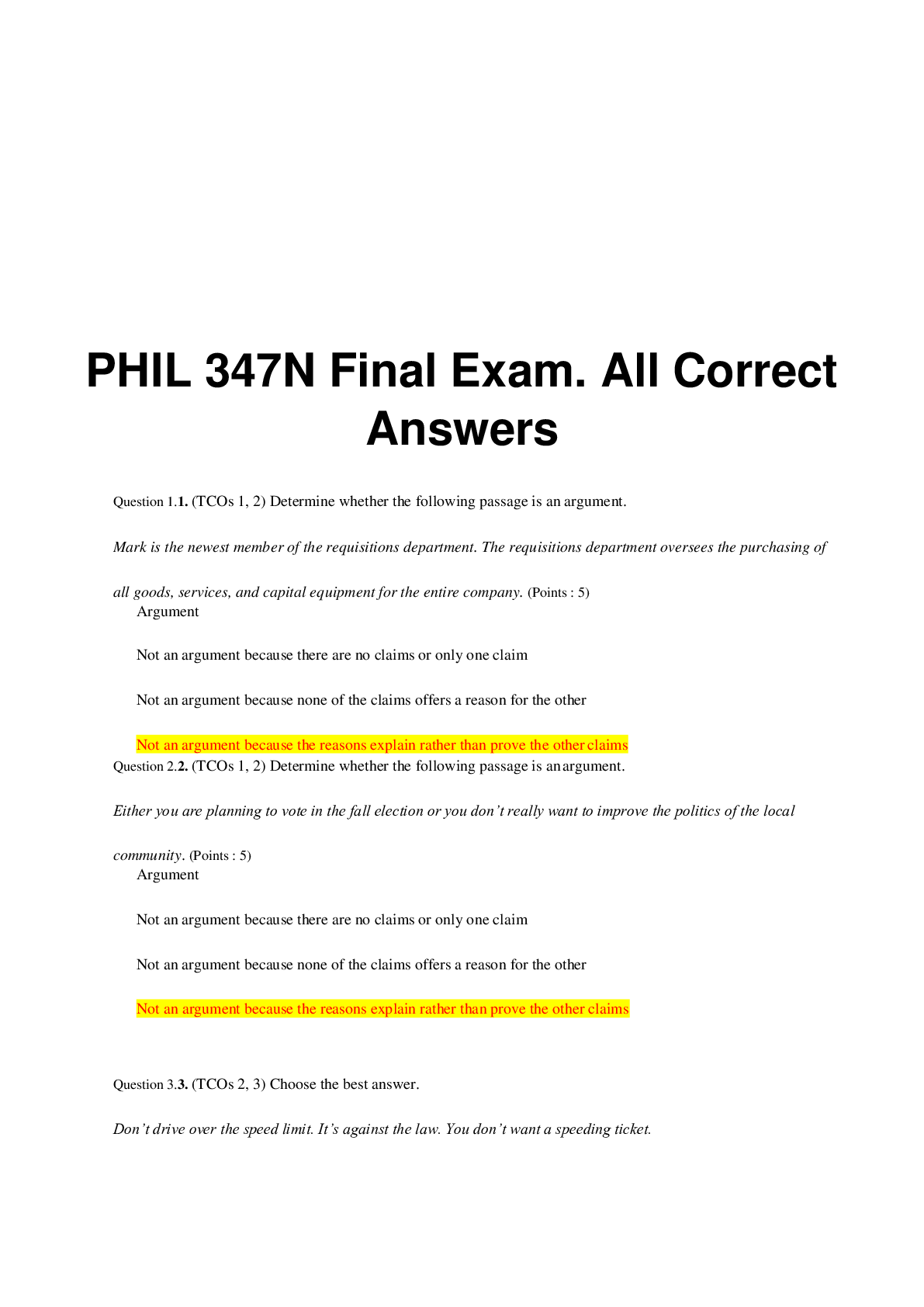Physics > QUESTIONS & ANSWERS > PHSC 1401PHET Projectile Motion Lab. Projectile Motion PhET Lab. 50 Questions and Answers. Topics � (All)
PHSC 1401PHET Projectile Motion Lab. Projectile Motion PhET Lab. 50 Questions and Answers. Topics Kinematics Gravity 2-Dimensional Motion Projectiles
Document Content and Description Below
Projectile Motion PhET Lab Topics • Kinematics • Gravity • 2-Dimensional Motion • Projectiles 1. The Kinematics equations are some of the fundamentals for how we define an object’s mot... ion, and they will be directly involved in the explanation of a projectile’s flight path. 2. Notably, when dealing with projectile motion, if there is an absence of air resistance, the only force acting on an object will be the vertical force resulting from gravity (where g=-9.8m/s2 and Fg=m∗g ). 3. Due to this absence of a horizontal force, if air resistance is not a factor we treat horizontal velocity as constant, and so differences in the object’s motion are largely going to be caused by its initial velocity and its angle of fire. 4. When describing the motion of an object with respect to two dimensions, it is best to maintain a separation between these two dimensions. In essence, it is best to split projectile motion into x and y components, solve each part separately, and then analyze how the two parts work together. 5. Most commonly, the formula used to describe projectile motion will be derived from the Kinematics formula x f= 12 a x t2+v x0 t+x0 . The derived formula applies to the vertical, so it is displayed with y’s as the variable for position and gravity as acceleration, but understand that it is fundamentally identical to the equation above. yf - y0=vy 0t + 1 2 gt2 6. As a reminder, in order to break apart a velocity vector (with velocity v0) at an angle θ into its x and y components, we use the formulas vx 0=v0∗cosθ and v0 y=v0∗sin θ 7. The vertical Kinematics formula, provided with an initial velocity, can be used to obtain a flight time using the height of the cannon and the ground your projectile lands on. 8. Go to the PHET physics simulations and open the “Projectile Motion” simulation. https://phet.colorado.edu/sims/html/projectile-motion/latest/projectile-motion_en.html Motion Without Friction 9. Click on “Intro” and make the rest of the settings match the image below. 10. Note the slider for initial speed on the bottom of the screen. This will allow you to change the initial speed of your projectile in increments of 1 m/s. For now, keep the angle of the cannon as it is (0o). For the sake of clarity, in any questions referenced in this lab, a “bullseye” is indicated by the target showing 3 stars when it is hit by a projectile. 11. Without changing any settings, firing the cannon will cause the projectile to ____________ the target. a. Go past b. Fall short of c. Hit the edge of d. Hit the bullseye of 12. From the angle of 0o, change the initial velocity to try and hit the target. From this firing angle, is it possible to hit the bullseye in the simulation? a. Yes b. No 13. Which initial velocity lands within the target? (Select all that apply) a. 5 m/s b. 10 m/s c. 11 m/s d. 12 m/s 14. Change the initial velocity to 10 m/s. Now, freely adjust the angle at which the cannon fires. At this speed, is it possible to hit the bullseye in the simulation? a. Yes b. No 15. Which angle gets you nearest to the bullseye? (Select all that apply) a. 5o b. 10o c. 25o d. 50o 16. Use the slider on the left to reduce the height of the cannon to 0 m (as shown below). Set the initial velocity to 15 m/s. 17. Move the angle of the cannon around freely. Which angle of fire allows the projectile to fly farthest? a. 25o b. 45o c. 65o d. 90o 18. Using the point-data tool (pictured below), you can analyze the time after firing, x-distance (range) and y-distance (height) of a projectile at its highest point (the green dot on its flight path) and at the point the projectile lands. 19. With the initial velocity set to 15 m/s and an angle of 30o, fire the cannon. Using the point-data tool, what is the time of the projectile’s highest point? 20. In the scenario from the previous question, what was the time of impact when the projectile landed? a. 0.00 s b. 0.26 s c. 0.76 s d. 1.53 s 21. Using the formula v y 0=v0∗sin θ , what was the initial y-velocity in the previous two questions? 22. With the initial velocity set to 15 m/s and an angle of 45o, fire the cannon. Using the point-data tool, what is the time of the projectile’s highest point? a. 0.54 s b. 0.76 s c. 1.08 s d. 2.16 s 23. In the scenario from the previous question, what was the time of impact when the projectile landed? 24. Using the Formula v y 0=v0∗sin θ , what was the initial y-velocity in the previous two questions? a. vy0 = 7.50 m/s b. vy0 = 10.6 m/s c. vy0 = 11.6 m/s d. vy0 = 43.5 m/s 25. Using the values collected from #19, #21, #22, and #24, which of the following could be a formula to find th, the time at which a projectile reaches its highest point? c. th=v y0∗sin θ∗0.144 d. th=v y0∗sin θ∗0.203 26. Using the formula selected above, what is the approximate time of the highest point of a projectile when it is fired at 20.0 m/s at an angle of 25.0o? a. th= 0.862 s b. th= 1.72 s c. d. th= 0.724 s 27. Using the velocity and angle described above, fire the cannon. Using the point-data tool, what is the time of the highest point? a. th= 0.51 s b. c. th= 0.86 s d. th= 1.72 s Range 28. Set the initial velocity of the cannon to 15 m/s, allowing the angle to be changed freely (still at an initial height of 0 m). Does the projectile that travels the farthest have the longest possible flight time of all available angles? a. Yes b. No 29. Which is a correct explanation for the answer above? a. The projectile being in the air for the longest possible time allows it to travel farther b. A longer flight time allows time for gravity to accelerate the projectile c. d. Because flight time is caused by vertical velocity, a longer flight time sacrifices horizontal speed 30. Keeping an initial velocity of 15 m/s, at an angle of 30o, what is the total distance traveled by the projectile? a. 19.86 m b. c. 27.09 m d. 31.24 m 31. Keeping an initial velocity of 15 m/s, at an angle of 45o, what is the total distance traveled by the projectile? a. 19.86 m b. 22.94 m c. 27.09 m d. 32. Using the formula v x 0=v0∗cosθ , what is the initial x-velocity in question #30? a. 7.50 m/s b. 7.76 m/s c. 13.0 m/s d. 29.0 m/s 33. Using the formula v x 0=v0∗cosθ , what is the initial x-velocity in question #31? a. 11.6 m/s b. 10.6 m/s c. d. 43.5 m/s 34. Using the values obtained in #30, #31, #32, and #33, as well as the formula for th obtained in #25, what is the formula for d, the distance a projectile flies away from a cannon (assuming a level surface)? a. d=v x 0∗th b. d= v x 0 th c. d. d=2∗v x 0∗th 35. Using the formula above, what would the expected range of a projectile be with an initial velocity of 10.00 m/s at angle of 35.00o? a. 9.579 m b. c. 14.01 m d. 7.005 m 36. In the simulation, what is the actual range of a projectile fired with an initial velocity of 10 m/s at an angle of 35o? a. 9.58 m b. 4.79 m c. 14.01 m d. Application 37. In all of the previous questions, we have kept the mass of our projectile constant. Are any of the formulas that describe our object motion dependent on mass? a. Yes b. No 38. If projectile motion is independent of mass, why do many of the technologies that fire projectiles (cannons, catapults, etc.) typically choose to fire dense materials like rocks or metal? a. Metal and rocks were easier to find than any other materials at the time b. The heavier materials were not as quickly affected by the force of gravity, allowing them to fly for longer times c. Our projectile motion formulas assume no air resistance, but that resistance is present in real projectile motion and affects less dense objects more d. The heavier projectiles were chosen because it was known that projectile motion did not care about mass, so the technologies opted for the heaviest projectiles possible to increase damage to whatever was hit. 39. What would be the result(s) of adding air resistance to our projectile motion problems? (Select all that apply) a. The introduction of air resistance would cause a force that decelerates the projectile with respect to its x-motion b. The introduction of air resistance would reduce the range of the fired projectile c. The introduction of air resistance would increase the range of the fired projectile d. The introduction of air resistance would decrease the maximum height of the fired projectile e. The introduction of air resistance would increase the maximum height of the fired projectile 40. Assuming a flat surface with no air resistance, if a projectile is fired at an angle of 30.0o with an initial velocity of 50.0 m/s, what will be the time it reaches its maximum height? a. 2.34 s b. 2.55 s c. 1.97 s d. 4.41 s 41. Assuming a flat surface with no air resistance, if a projectile is fired at an angle of 30.0o with an initial velocity of 50.0 m/s, what will be the object’s maximum height? (Remember yf-y0=v y 0t + 12 g t2 ) a. 31.9 m b. 63.8 m c. 95.7 m d. 30.4 m 42. Assuming a flat surface with no air resistance, if a projectile is fired at an angle of 30.0o with an initial velocity of 50.0 m/s, what will be the object’s total horizontal distance traveled? a. b. 63.7 m c. 110 m d. 127 m 43. Assuming a cannon elevated 10 m above the ground with no air resistance, if a projectile is fired at an angle of 30.0o with an initial velocity of 50.0 m/s, what will be the object’s total horizontal distance traveled? (Remember yf=y0+v y0 t+ 1 2 g t2 and xf=1 2 a xt2+vot+x0 ) a. 5.47 m b. 127 m c. 192 m d. 237 m Review 44. Without the presence of air resistance, for the x-component in projectile motion, acceleration is _______? a. a = 0.0 m/s2 b. a = -4.9 m/s2 c. a = 9.81 m/s2 d. a = -9.81 m/s2 45. Without the presence of air resistance, for the y-component in projectile motion, acceleration is _______? a. 46. Assuming a lack of air resistance and an even surface, what angle results in a projectile firing furthest? a. 30o b. 45o c. 60o d. 90o 47. Assuming a lack of air resistance and an even surface, what angle results in a projectile firing highest? a. 30o b. 45o c. 60o d. 90o 48. Ignoring air resistance, how much farther would a cannonball (m1=10 kg) fly than a paper ball (m2=0.05 kg) when fired with a velocity of 10 m/s at an angle of 35o? a. d. 10 m 49. (Free Response) We will discuss the effect of forces on objects of differing masses in upcoming sections, but with your current knowledge and what has been discussed previously, why do you think mass would be relevant for motion with air resistance, but appears irrelevant for vertical motion when air resistance is not present? [Show More]
Last updated: 2 years ago
Preview 1 out of 6 pages

Buy this document to get the full access instantly
Instant Download Access after purchase
Buy NowInstant download
We Accept:

Reviews( 0 )
$12.00
Can't find what you want? Try our AI powered Search
Document information
Connected school, study & course
About the document
Uploaded On
Apr 01, 2021
Number of pages
6
Written in
Additional information
This document has been written for:
Uploaded
Apr 01, 2021
Downloads
0
Views
174














